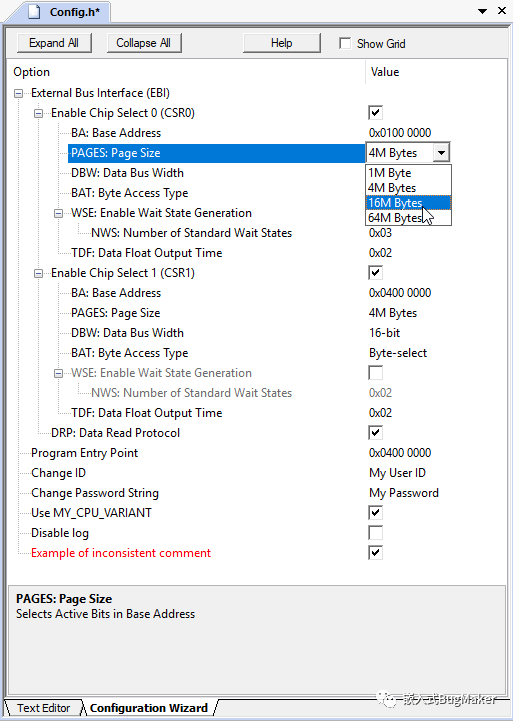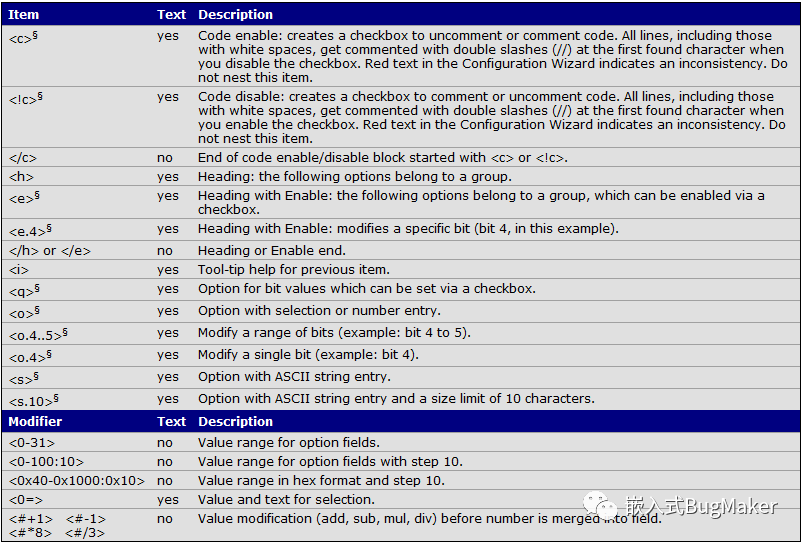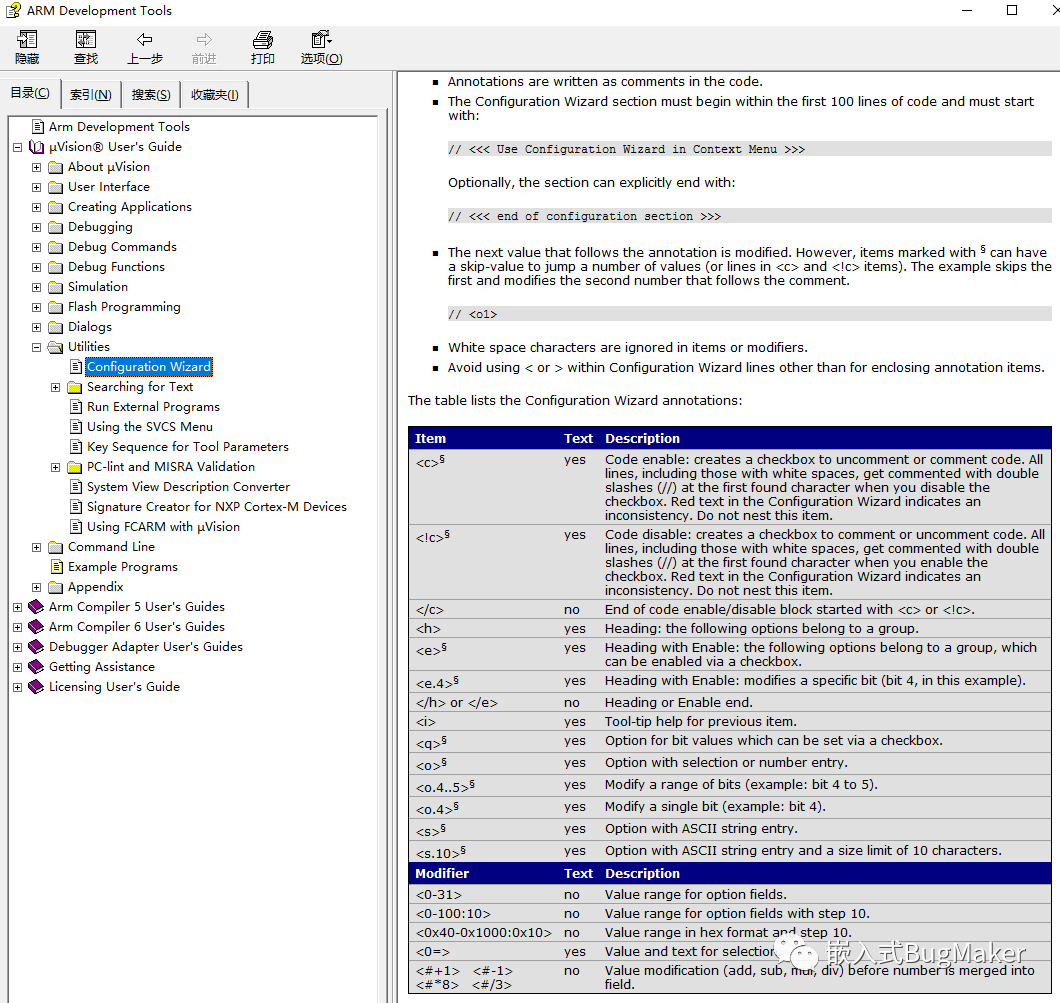

KEIL编程小技巧-配置向导
电子说
1.4w人已加入
描述
介绍
Keil作为使用广泛的一款嵌入式开发IDE,大多数的工程师只用到了编译和仿真功能,其实只需要一些编程小技巧就可以通过Keil将代码的一些配置可视化。
本篇将要介绍的是Keil的一项功能叫做 Configuration Wizard (配置向导),这是内嵌在Keil编辑器中的一项功能,按照既定规则在代码中标记后则可以产生配置可视化的效果(如下图所示),由于是以注释的形式进行标记,所以并不会实际影响代码的移植编译以及正常功能。

配置向导语法
当编辑器检测到代码中存在有
//***< < < Use Configuration Wizard in Context Menu >> >***
并且以如下代码结束
//***< < < end of configuration section > > >***
那么Keil的编辑器则会识别并解析注释内容生成对应的图形化配置界面,编码的规则如下所示

范例代码
如下是介绍章节显示图对应的帮助文档提供的范例代码,可以参考实际编码操作一下
//*** < < < Use Configuration Wizard in Context Menu > > > ***
FUNC void Setup (void) {
// < h > External Bus Interface (EBI)
// < e1.13 > Enable Chip Select 0 (CSR0)
// < o1.20..31 > BA: Base Address < 0x0-0xFFF00000:0x100000 >< #/0x100000 >
// < i > Start Address for Chip Select Signal
// < o1.7..8 > PAGES: Page Size < 0= > 1M Byte < 1= > 4M Bytes
// < 2= > 16M Bytes < 3= > 64M Bytes
// < i > Selects Active Bits in Base Address
// < o1.0..1 > DBW: Data Bus Width < 1= > 16-bit < 2= > 8-bit
// < o1.12 > BAT: Byte Access Type < 0= > Byte-write
// < 1= > Byte-select
// < e1.5 > WSE: Enable Wait State Generation
// < o1.2..4 > NWS: Number of Standard Wait States < 1-8 >< #-1 >
// < /e >
// < o1.9..11 > TDF: Data Float Output Time < 0-7 >
// < i > Number of Cycles Added after the Transfer
// < /e >
_WDWORD(0xFFE00000, 0x010024A9); // EBI_CSR0: Flash
// < e1.13 > Enable Chip Select 1 (CSR1)
// < o1.20..31 > BA: Base Address < 0x0-0xFFF00000:0x100000 >< #/0x100000 >
// < i > Start Address for Chip Select Signal
// < o1.7..8 > PAGES: Page Size < 0= > 1M Byte < 1= > 4M Bytes
// < 2= > 16M Bytes < 3= > 64M Bytes
// < i > Selects Active Bits in Base Address
// < o1.0..1 > DBW: Data Bus Width < 1= > 16-bit < 2= > 8-bit
// < o1.12 > BAT: Byte Access Type < 0= > Byte-write
// < 1= > Byte-select
// < e1.5 > WSE: Enable Wait State Generation
// < o1.2..4 > NWS: Number of Standard Wait States < 1-8 >< #-1 >
// < /e >
// < o1.9..11 > TDF: Data Float Output Time < 0-7 >
// < i > Number of Cycles Added after the Transfer
// < /e >
_WDWORD(0xFFE00004, 0x040034A5); // EBI_CSR1: RAM
// < q1.4 > DRP: Data Read Protocol
// < 0= > Standard Read
// < 1= > Early Read
_WDWORD(0xFFE00024, 0x00000010); // EBI_MCR: Data Read Protocol
_WDWORD(0xFFE00020, 0x00000001); // EBI_RCR: Remap Command
// < /h >
// < o > Program Entry Point
PC = 0x04000000;
}
// < s > Change ID
// < s1.30 > Change Password String
#define ID "My User ID"
char pw[] = "My Password";
/*********************************************************/
/* Example for enabling and disabling code */
// < c1 > Use MY_CPU_VARIANT
// < i > Use MY_CPU_VARIANT, and set the include file
#define MY_CPU_VARIANT
#include "MyCpuVariant.h"
// < /c >
// < !c1 > Disable log
// < i > Disable log file generation
#define _USE_LOG
// < /c >
// < c1 > Example of inconsistent comment
// < i > a mix of commented and uncommented lines in the block create an inconsistency
// This type of comment, mixed with uncommented lines, creates the inconsistency
/* You can use this type of comment without creating an inconsistency */
do_whatever; // adding this type of comment here is allowed
// < /c >
//*** < < < end of configuration section > > > ***
如有兴趣,那么可以查看Keil帮助文档中的配置向导部分内容,文档内容位置如下图所示,实际配置效果大家自行动手实践一下能加深印象。

声明:本文内容及配图由入驻作者撰写或者入驻合作网站授权转载。文章观点仅代表作者本人,不代表电子发烧友网立场。文章及其配图仅供工程师学习之用,如有内容侵权或者其他违规问题,请联系本站处理。
举报投诉
-
使用TLE9893-2QK运行电机,Keil无法连接到TLE9398配置向导,如何解决?2024-06-21 760
-
缺少TCP IP配置向导和库2019-09-06 1144
-
STM32F407+Cube配置+IAR和Keil编程简析2022-01-24 451
-
keil C51安装向导2013-11-15 521
-
KEIL_MDK配置参考手册v2.02016-01-13 542
-
Keil的黑色界面配置文件和配置方法2019-12-03 1536
-
keil单片机编程软件的使用方法说明2020-08-15 17568
-
KEIL for ARM 5.33最新版无法正常编译怎么办?2021-02-02 6825
-
【转载】配置Keil C51配置开发 STC51单片机过程2021-11-13 1197
-
【单片机】Keil+Proteus流水灯(模块化编程)2021-11-17 948
-
基于Keil5的51单片机环境配置(附带2032、VSCODE编辑环境配置与卸载教程)2021-11-22 1696
-
keil arm单片机编程软件套装2021-11-23 815
-
C8051F320 Silicon Labs IDE / Keil µVision / IAR for 8051 开发环境搭建2021-11-25 1750
-
Keil5软件配置与新建STM32工程的步骤2022-02-08 1477
-
MDK的配置向导介绍2023-11-23 1619
全部0条评论

快来发表一下你的评论吧 !

